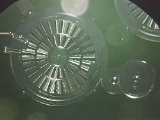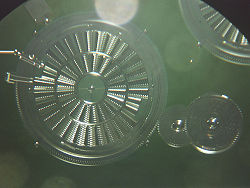
Micromachinery
Encyclopedia


Mechanics
Mechanics is the branch of physics concerned with the behavior of physical bodies when subjected to forces or displacements, and the subsequent effects of the bodies on their environment....
objects that are fabricated in the same general manner as integrated circuits. They are generally considered to be between 100 nanometre
Nanometre
A nanometre is a unit of length in the metric system, equal to one billionth of a metre. The name combines the SI prefix nano- with the parent unit name metre .The nanometre is often used to express dimensions on the atomic scale: the diameter...
s to 100 micrometre
Micrometre
A micrometer , is by definition 1×10-6 of a meter .In plain English, it means one-millionth of a meter . Its unit symbol in the International System of Units is μm...
s in size, though that is debatable. The applications of micromachines include accelerometer
Accelerometer
An accelerometer is a device that measures proper acceleration, also called the four-acceleration. This is not necessarily the same as the coordinate acceleration , but is rather the type of acceleration associated with the phenomenon of weight experienced by a test mass that resides in the frame...
s that detect when a car
Automobile
An automobile, autocar, motor car or car is a wheeled motor vehicle used for transporting passengers, which also carries its own engine or motor...
has hit an object and trigger an airbag
Airbag
An Airbag is a vehicle safety device. It is an occupant restraint consisting of a flexible envelope designed to inflate rapidly during an automobile collision, to prevent occupants from striking interior objects such as the steering wheel or a window...
. Complex systems of gear
Gear
A gear is a rotating machine part having cut teeth, or cogs, which mesh with another toothed part in order to transmit torque. Two or more gears working in tandem are called a transmission and can produce a mechanical advantage through a gear ratio and thus may be considered a simple machine....
s and lever
Lever
In physics, a lever is a rigid object that is used with an appropriate fulcrum or pivot point to either multiply the mechanical force that can be applied to another object or resistance force , or multiply the distance and speed at which the opposite end of the rigid object travels.This leverage...
s are another application.
The fabrication of these devices is usually done by one or both of two techniques: surface micromachining
Surface micromachining
Unlike Bulk micromachining, where a silicon substrate is selectively etched to produce structures, surface micromachining builds microstructures by deposition and etching of different structural layers on top of the substrate....
and bulk micromachining
Bulk micromachining
Bulk micromachining is a process used to produce micromachinery or microelectromechanical systems .Unlike surface micromachining, which uses a succession of thin film deposition and selective etching, bulk micromachining defines structures by selectively etching inside a substrate...
.
Most micromachines act as transducer
Transducer
A transducer is a device that converts one type of energy to another. Energy types include electrical, mechanical, electromagnetic , chemical, acoustic or thermal energy. While the term transducer commonly implies the use of a sensor/detector, any device which converts energy can be considered a...
s; in other words, they are either sensor
Sensor
A sensor is a device that measures a physical quantity and converts it into a signal which can be read by an observer or by an instrument. For example, a mercury-in-glass thermometer converts the measured temperature into expansion and contraction of a liquid which can be read on a calibrated...
s or actuator
Actuator
An actuator is a type of motor for moving or controlling a mechanism or system. It is operated by a source of energy, usually in the form of an electric current, hydraulic fluid pressure or pneumatic pressure, and converts that energy into some kind of motion. An actuator is the mechanism by which...
s.
Sensors convert information from the environment into interpretable electrical signals. One example of a micromachine sensor is a resonant chemical sensor. A lightly damped mechanical object vibrates much more at one frequency than any other, and this frequency is called its resonance frequency. A chemical sensor is coated with a special polymer
Polymer
A polymer is a large molecule composed of repeating structural units. These subunits are typically connected by covalent chemical bonds...
that attracts certain molecule
Molecule
A molecule is an electrically neutral group of at least two atoms held together by covalent chemical bonds. Molecules are distinguished from ions by their electrical charge...
s, such as those found in anthrax
Anthrax
Anthrax is an acute disease caused by the bacterium Bacillus anthracis. Most forms of the disease are lethal, and it affects both humans and other animals...
, and when those molecules attach to the sensor, its mass
Mass
Mass can be defined as a quantitive measure of the resistance an object has to change in its velocity.In physics, mass commonly refers to any of the following three properties of matter, which have been shown experimentally to be equivalent:...
increases. The increased mass alters the resonance frequency of the mechanical object, which is detected with circuitry.
Actuators convert electrical signals and energy into motion of some kind. The three most common types of actuators are electrostatic
Electrostatics
Electrostatics is the branch of physics that deals with the phenomena and properties of stationary or slow-moving electric charges....
, thermal
Thermal
A thermal column is a column of rising air in the lower altitudes of the Earth's atmosphere. Thermals are created by the uneven heating of the Earth's surface from solar radiation, and are an example of convection. The sun warms the ground, which in turn warms the air directly above it...
, and magnetic
Magnetism
Magnetism is a property of materials that respond at an atomic or subatomic level to an applied magnetic field. Ferromagnetism is the strongest and most familiar type of magnetism. It is responsible for the behavior of permanent magnets, which produce their own persistent magnetic fields, as well...
. Electrostatic actuators use the force of electrostatic energy to move objects. Two mechanical elements, one that is stationary (the stator
Stator
The stator is the stationary part of a rotor system, found in an electric generator, electric motor and biological rotors.Depending on the configuration of a spinning electromotive device the stator may act as the field magnet, interacting with the armature to create motion, or it may act as the...
) and one that is movable (the rotor
Rotor (electric)
The rotor is the non-stationary part of a rotary electric motor, electric generator or alternator, which rotates because the wires and magnetic field of the motor are arranged so that a torque is developed about the rotor's axis. In some designs, the rotor can act to serve as the motor's armature,...
) have two different voltages applied to them, which creates an electric field
Electric field
In physics, an electric field surrounds electrically charged particles and time-varying magnetic fields. The electric field depicts the force exerted on other electrically charged objects by the electrically charged particle the field is surrounding...
. The field competes with a restoring force on the rotor (usually a spring force produced by the bending or stretching of the rotor) to move the rotor. The greater the electric field, the farther the rotor will move. Thermal actuators use the force of thermal expansion to move objects. When a material is heated, it expands and amount depending on material properties. Two objects can be connected in such a way that one object is heated more than the other and expands more, and this imbalance creates motion. The direction of motion depends on the connection between the objects.
This is seen in a "heatuator", which is a U-shaped beam with one wide arm and one narrow arm. When a current is passed through the object, heat is created. The narrow arm is heated more than the wide arm because they have the same current density. Since the two arms are connected at the top, the stretching hot arm pushes in the direction of the cold arm. Magnetic actuators used fabricated magnetic layers to create forces.
To do bulk micromachining, the region needed is highly doped with boron and the unwanted silicon is etched in liquid silicon etches. This technique is termed an etchstop as the doping of boron produces an unetchable layer/pattern.

